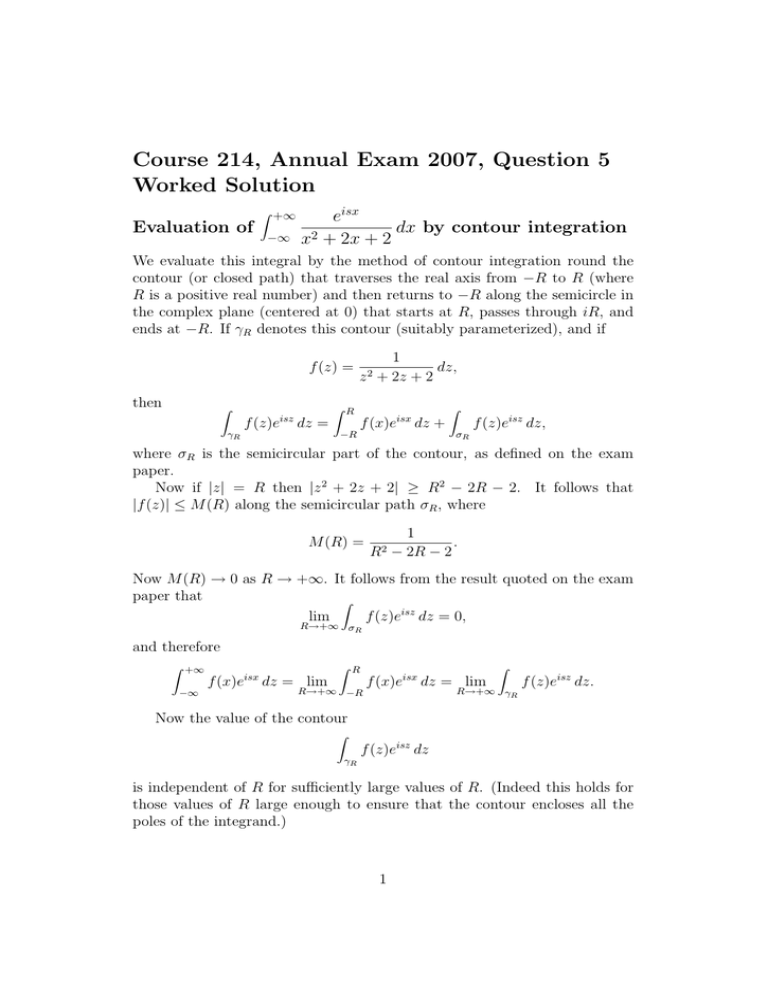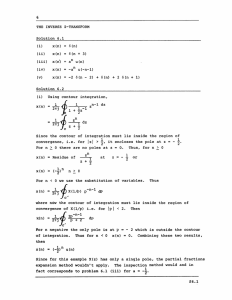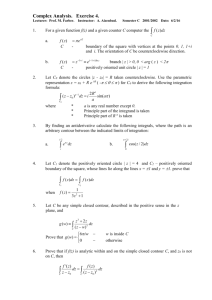Course 214, Annual Exam 2007, Question 5 Worked Solution e Evaluation of
advertisement

Course 214, Annual Exam 2007, Question 5 Worked Solution Evaluation of Z +∞ −∞ eisx dx by contour integration x2 + 2x + 2 We evaluate this integral by the method of contour integration round the contour (or closed path) that traverses the real axis from −R to R (where R is a positive real number) and then returns to −R along the semicircle in the complex plane (centered at 0) that starts at R, passes through iR, and ends at −R. If γR denotes this contour (suitably parameterized), and if f (z) = then Z f (z)eisz dz = Z R z2 1 dz, + 2z + 2 f (x)eisx dz + −R γR Z f (z)eisz dz, σR where σR is the semicircular part of the contour, as defined on the exam paper. Now if |z| = R then |z 2 + 2z + 2| ≥ R2 − 2R − 2. It follows that |f (z)| ≤ M (R) along the semicircular path σR , where M (R) = R2 1 . − 2R − 2 Now M (R) → 0 as R → +∞. It follows from the result quoted on the exam paper that Z lim f (z)eisz dz = 0, R→+∞ σR and therefore Z +∞ −∞ isx f (x)e dz = lim Z R isx R→+∞ −R f (x)e dz = lim Z R→+∞ γR f (z)eisz dz. Now the value of the contour Z f (z)eisz dz γR is independent of R for sufficiently large values of R. (Indeed this holds for those values of R large enough to ensure that the contour encloses all the poles of the integrand.) 1 We evaluate the contour integral using Cauchy’s Residue Theorem. For that we need to know the locations of the poles of the integrand, and the residues of the integrand at those poles. Now z 2 + 2z + 2 = (z + 1 − i)(z + 1 + i), The poles of the function f , and thus those of the integrand, are located at −1+i and −1−i. Now the pole at −1+i is located in the upper half plane, and therefore the contour γR has winding number +1 about this pole. (The pole is located inside the semicircular contour, and the contour winds once in the anticlockwise direction around this pole.) Thus n(γR , −1 + i) = 1 (where the quantity on the left denotes the winding number of the closed curve around the pole). On the other hand, the pole at −1 − i is located in the lower half plane and therefore lies outside the contour, and therefore the contour has zero winding number about this pole. Therefore n(γR , −1 − i) = 0. It follows from Cauchy’s Residue Theorem that Z γR f (z)eisz dz = 2πib−1+i , where b−1+i denotes the residue of the integrand at the pole located at −1+i. Moreover b−1+i = lim z→−1+i eisz (z + 1 − i) 2 z + 2z + 2 ! eisz e−is−s = . z→−1+i z + 1 + i 2i = lim Therefore Z +∞ −∞ eisx e−is−s dx = 2πi = πe−is−s = πe−s (cos s − i sin s). x2 + 2x + 2 2i Evaluation of Z +∞ −∞ eisx dx by contour integration x4 + 1 Let the paths γR and σR be the same as in the previous evaluation. Then we have to evaluate Z +∞ f (z)eisz dz, −∞ where 1 dz. +1 Now |f (z)| ≤ M (R) for all complex numbers z on the circle |z| = R, where f (z) = z4 M (R) = 2 1 . R4 − 1 Also M (R) → 0 as R → +∞, and therefore Z lim R→+∞ σR f (z)eisz dz = 0, so that Z +∞ isx f (x)e dz = lim Z R R→+∞ −R −∞ isx f (x)e dz = lim Z R→+∞ γR f (z)eisz dz. Now z 4 + 1 = (z 2 + i)(z 2 − i). Also ! 1 z − √ (1 − i) , 2 ! 1 z − √ (1 + i) . 2 1 z + i = z + √ (1 − i) 2 2 1 z − i = z + √ (1 + i) 2 2 ! ! It follows that z 4 + 1 = (z − w1 )(z − w2 )(z − w3 )(z − w4 ), where 1 w1 = √ (1 + i), 2 1 w2 = √ (−1 + i), 2 1 w3 = √ (1 − i), 2 1 w4 = √ (−1 − i). 2 The integrand thus has four poles, located at w1 , w2 , w3 and w4 . Now w1 and w2 are located in the upper half plane, and therefore, for sufficiently large R, the contour has winding number +1 about these poles. On the other hand, w3 and w4 are located in the lower half plane, and therefore the contour has winding number zero about these poles. It follows from Cauchy’s Residue Theorem that, for large R, Z γR f (z)eisz dz = 2πi(bw1 + bw2 ). where bwi denotes the residue of the integrand at wi , for i = 1 and i = 2. Now eisz = z→w lim (z − w1 ) 4 1 z +i eisz = z→w lim 1 (z − w2 )(z − w3 )(z − w4 ) eisw1 = (w1 − w2 )(w1 − w3 )(w1 − w4 ) ! bw1 √s (−1+i) e 2 √ , = 2i 2(1 + i) 3 and eisz = lim (z − w2 ) 4 z→w2 z +i eisz = lim z→w2 (z − w )(z − w )(z − w ) 1 3 4 isw2 e = (w2 − w1 )(w2 − w3 )(w2 − w4 ) ! bw2 √s (−1−i) e 2 √ . = 2i 2(1 − i) It follows that Z +∞ −∞ √s (−1+i) eisx π e 2 √ dx = x4 + 1 1+i 2 + e √s (−1−i) 2 1−i s s s s cos √ − i sin √ cos √ + i sin √ 2 2 2 2 + 1+i 1−i π − √s = √ e 2 2 ! s s π − √s = √ e 2 cos √ + sin √ . 2 2 2 4






